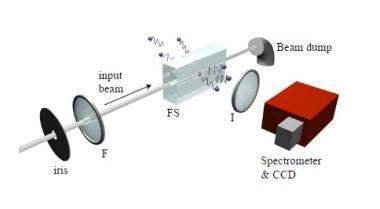September 28, 2010 report
Physicists may have observed Hawking radiation for the first time

(PhysOrg.com) -- In 1974, Stephen Hawking predicted that black holes emit thermal radiation due to quantum effects, which causes the black holes to lose mass and perhaps ultimately vanish. But despite numerous attempts to observe Hawking radiation, astronomers have so far detected no sign of it. Now, however, a team of scientists from Italy claims to have observed something that looks very much like Hawking radiation from an event hole horizon they created in the lab.
Franco Belgiorno at the University of Milan and his coauthors will publish their study in a future issue of Physical Review Letters, and the paper is currently available on arXiv.org.
As the physicists explain in their study, the essential ingredient of Hawking radiation is not the black hole itself but rather the space-time curvature associated with the black hole's event horizon. The event horizon acts as a boundary beyond which light cannot escape. So particle pairs excited from the vacuum that form close to the black hole horizon are split so that the inner photon falls in and the outer photon escapes, gaining energy at the expense of the black hole.
Event horizons are not unique to black holes; they can be exhibited in a variety of physical systems, from flowing water to a moving “refractive index perturbation” (RIP) in a dielectric medium (in which light can change the medium's refractive index). It's this latter system that Belgiorno and his colleagues used in their experiment.
To create the Hawking radiation, the scientists fired ultrashort (1-picosecond) laser pulses at transparent glass, which excited an RIP that exhibited an event horizon. Using a CCD camera, the researchers detected a peculiar kind of photon emission at a 90-degree angle to the glass. As the researchers explained, they arranged the experiment in a way to strongly suppress or eliminate other types of radiation, such as Cerenkov-like radiation, four wave mixing, self-phase modulation, Rayleigh scattering, and fluorescence.
“[W]e report experimental evidence of photon emission that on one hand bears the characteristics of Hawking radiation and on the other is distinguishable and thus separate from other known photon emission mechanisms,” the physicists wrote in their study. “We therefore interpret the observed photon emission as an indication of Hawking radiation induced by the analogue event horizon.”
Interestingly, the physicists note that there are actually two event horizons associated with the RIP. Besides the black hole horizon, there is also the black hole horizon's inverse called a white hole horizon. As the laser light approaches the RIP, the light experiences an increase in the local refractive index, causing it to slow down. Under appropriate conditions, the light can be brought to a standstill in the reference frame comoving with the RIP, which forms a boundary beyond which light is unable to penetrate: the white hole event horizon. In the case of the RIP, the leading edge is the analogue of the black hole horizon and the trailing edge is the analogue of the white hole horizon.
With these observations, the physicists have shown that it's possible to investigate the physics of black hole evaporation in other, more accessible systems. If future experiments confirm that this is Hawking radiation, the results could have implications on everything from the fate of black holes to how the universe may end.
More information:
F. Belgiorno, et al. "Hawking radiation from ultrashort laser pulse filaments." Physical Review Letters. To be published. Available at arXiv:1009.4634v1.
via: The Physics ArXiv Blog
© 2010 PhysOrg.com



















